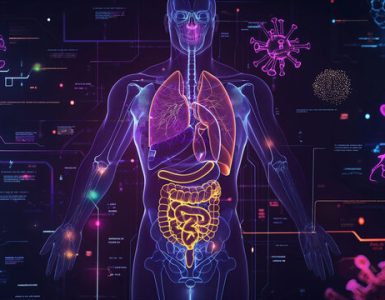by Katherine Vazquez
The Andersons At Home
It is 7 a.m. and Brian and Maggie Anderson are just waking up for school. Their mother forgot to pack their lunches again last night so they will have to rely on the bottles of Insta-meal conveniently chilled in the fridge. Mrs. Anderson once believed it to be nutritious and quick on-the-go sustenance. The soy meal replacement is marketed to prevent that mid-afternoon carb-crash and improve performance in school, but, as far as she can tell, it’s not working. Brian quickly forges his mother’s signature on his latest geometry quiz- another F- before trudging out the door with his sister. They nearly miss the school bus.
In a hurry herself, Mrs. Anderson manages to chug down a bottle for breakfast. She convinces herself that it is somewhat palatable, like a combination of expired peanut butter and almond milk. A pang of guilt washes over her and she convinces herself she will remember to pack lunch that evening. She runs to her room and puts on a blouse and a wrinkled pair of slacks which she struggles to pull up over her waist. She is severely bloated from the morning’s pablum. She hopes her flatulent belly could be a sign of pregnancy, as she has had no luck on a third child for the past two of years. The bills from the fertility doctor are piling up and she has taken on a second shift at work.
Mr. Anderson quietly flexes his biceps in the mirror before brushing his teeth. He still looks good for a man in his late 40’s. Something in the mirror catches his eye. His chest has been slowly developing for the past few months and now he appears close to lactation. Gynecomastia is typical in men past a certain age, he thinks, and he has been drinking a few more beers than he should with his meals. His health is mostly good, and like everyone else nowadays he consumes a completely meatless diet. He knows he is making a sound choice whenever he grills up his favorite cruelty-free burgers. Composed of the most sophisticated GMO soy ingredients, they even “bleed” a little when prodded as they char up under barbecue sauce. But now as he examines himself closely, he faintly recalls his grandma repeating the old wives’ tale that too much soy is feminizing and may lower sperm count.
Many more people apart from the Andersons are suffering from the latest advancements in technology and Big Agriculture. Many small farmers and butchers have had to close their shops and jump on the vegetarian or GMO bandwagon. They were unable to compete with the low prices and health and environmental claims of their competitors. Industrialized livestock agriculture is now effectively obsolete. Older folks who once used to crave and eat meat freely and publicly are now forced to bear their shame quietly. There is no more reflecting on “the good old days” and the concepts of the milkman, dairy farms and organic, non-GMO farming are soon to be obliterated from the minds of the youth.
An Impossible Feat
While the fictional account of the Andersons may seem far-fetched, we are creeping eerily closer to this new kind of reality. Patrick Browne, The CEO of the booming meat substitute brand Impossible Meat, recently admitted that the mission of the company is to eliminate the meat industry within the next 15 years. And he is well poised to reach his goal. His most recent alliance is with the behemoth that is Starbucks.
“Starbucks was one of our — if not the top — targeted outlet, just because of the power of their brand and their ubiquity,” he said. “It’s just a great opportunity for exposure and trial.”
The Impossible Breakfast Sandwich is a plant-based sausage now offered at more than 15,200 domestic stores across the nation. Starbucks seeks to provide more environmentally friendly food options and Impossible Foods is now targeting a younger audience with a healthier and more sustainable mock-meat. Brown noted that about a third of the Americans ages 18-29 visit a Starbucks restaurant an average of once a month. The deal will help the company reach the young adult demographic.
Perhaps unbeknownst to the average consumer, the key ingredient of Impossible Meat’s products is GMO soy. According to their website, genetic engineering is “an essential part of our mission and our product.” They use two genetically engineered ingredients: heme (soy leghemoglobin) and soy protein. To make heme, which gives the faux meat an authentic taste, they take the DNA for soy leghomoglobin, insert it into yeast, and ferment the yeast. Additionally, they source genetically engineered soy protein from farms in Iowa. Their kitchen chemistry perfectly exemplifies how science and technology merge to create an uncanny simulacrum of real food.
The Emergence of Soylent
On the heels of pioneers in the meat imitation industry, Soylent complete meal replacement is quickly rising as another popular soy-based diet staple. After its inception at the hands of software engineers in 2013, Soylent has been paraded under the innocuous banner of making adequate nutrition more affordable for all people rich and poor. While the concept is nice, the product is mainly soy protein isolate- which is the cheap, isolated protein from the soybean that is genetically engineered to create a higher quality of protein. The makers of Soylent designed it to include all the nutrients necessary for optimal health and claim it can be safely imbibed up to three times a day. Alarmingly, independent labs confirmed high levels of the toxic metals lead and cadmium in the powder in 2015.
What are GMOs?
A genetically modified organism, or GMO, is a plant or animal that has had its DNA changed or manipulated in some way through genetic engineering. Most of the time, GMOs have been tweaked with foreign DNA from another bacteria, plant, virus or animal. In agriculture, produce can be genetically altered to have a longer shelf life or increased nutrient value. The most widely cultivated GMOs like soy and corn are designed to tolerate dangerous herbicides like glyphosate.
In 1996, GMO crops were first introduced for commercial production. Since then, their use has soared precipitously. Not all GMOs are crop plants. Non-plant genetically modified organisms also have applications in agriculture. For example, insects may be modified for insect pest control using enhanced vector systems, and viruses can be implemented as transient-expression vectors for disease management in plants.
What about the future of GMO?
Recent advances in gene-editing technology allow for effective site-specific genetic alterations without introducing foreign DNA. This new phase of genetic engineering has rolled out new breeding techniques (NBTs) like CRISPR and RdDM, as well as synthetic biology. These techniques facilitate more complex manipulation of the genes and metabolic pathways of plants and animals.
There is growing concern that these new innovations could lead to the spread of modified genes through entire wild populations via a gene ‘drive’ system. This system allows an altered gene on one chromosome to replicate itself onto a partner chromosome. As a result, most offspring will inherit an engineered gene. Gene drive could be useful to exterminate species, such as weeds and disease carrying pests. However, there are potential consequences for whole ecosystems when species are eliminated. If only a handful of organisms with gene drives are introduced into the wild, the whole population could eventually inherit the edited gene.
Many scientists worry that these new techniques could circumvent product-based GMO regulations and labeling. They allow companies to bypass the expensive and lengthy regulation processes tied to current GMO. These processes were initiated for important safety reasons.
Do the benefits outweigh the risks?
The use of GMOs to mass produce cheap, nutrient dense foods that minimize greenhouse gas emissions is noble. Unfortunately, there is no scientific consensus on the safety of GMOs.
Pleiotropy
DNA is a complicated structure. Modifying DNA in any way can lead to dramatic changes in a cell’s composition and relationship with other cells. Chemically, this is known as Pleiotropy.
Genes are not simple building blocks – if you tweak or remove one component, there are consequences well beyond the changed ‘piece’. Genes, proteins and pathways interact with each another and are controlled by a complex, multi-faceted network process. Regardless of what scientist claim, it is impossible to foresee the impact of even a minute gene alteration. Pleiotropic effects have included changes in the plant’s nutritional, toxic and allergenic potential.
For instance, a GMO soy examined in 1996, developed 27% higher concentrations of the known allergen, trypsin-inhibitor. In 2008, a GMO corn had the unexpected emergence of a new form of the protein which is a major allergen. Moreover, a 2013 study published in The Journal of Food Chemistry found that GMO soy accumulated high levels of the agrochemicals glyphosate and AMPA when compared to organically farmed soy. Glyphosate, a popular herbicide, is known to be associated with the cancer non-Hodgkin lymphoma.
Antibacterial resistance
Genetic modification, which can increase a crop’s disease resistance and tolerance to herbicides, may adversely affect the ability of humans to defend against illness. There is a small possibility that the genes found in food can transfer to gut bacteria or human body cells. Some GMO crops contain antibiotic-resistant genes. This resistance might spread to the humans consuming them. With the increased prescription of antibiotics, antibiotic resistance in humans has become a global crisis. GMOs may be contributing to that risk.
A New Outlook
There is an increasing demand for health-conscious products that are sustainable, ethical, and healthy. GMOs have emerged to try and meet that demand, and they are no doubt here to stay. With continued research and responsible use of technology the story of GMOs likely won’t have a grim ending. There is potential to create more food that is nutrient rich and make it available to people in developing countries, like the golden rice engineered to deliver beta-carotene to people deficient in Vitamin A or GMO-produced delayed ripening tomatoes. Prospective epidemiological studies for the evaluation of the effect of GMOS alone, and in combination with other agrochemicals, are lacking, and are critical for ensuring a more favorable outcome. If scientists can commit to more longitudinal studies involving large enough populations, we can safely harness new GMO technology without raising consumer concern.





